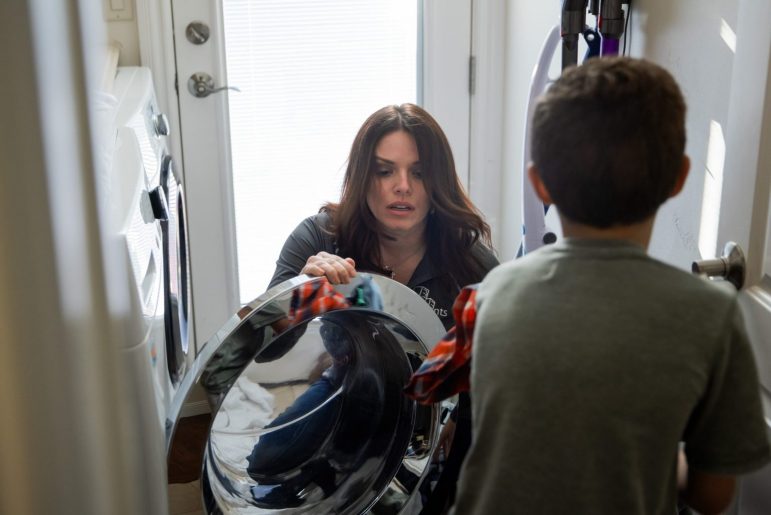School grounds are filling up at recess again as more students ditch virtual learning and return to brick-and-mortar classrooms. But for the many mothers who had to cut back on work during the pandemic as kids stayed home, back to school has not meant back to normal.
From sidelined businesses and lost income to night shifts and delayed health care, moms have paid a higher price during the pandemic.
Among working mothers who lived with a partner, 45.3% were providing all the care for kids at home, up from 33% before the pandemic, according to a USC study that analyzed survey responses last fall from 3,100 couples in the U.S. Just 8.7% of dads were the primary caregivers both before and during the pandemic, the study found.
Brandy Brager is one of them. The CEO of a five-person construction company, she used to be the kind of person who planned out a whole year ahead. Now, it’s day by day. “The way I think about my career changed,” said Brager, whose 10- and 12-year-old sons went back to school in San Jose in late March almost full time. “I had to cut my salary. My business had to take a bit of the back seat.”

“What we saw during this crisis was women taking on more at home even though they were still working,” said study co-author Gema Zamarro, a professor at the University of Arkansas and a senior economist at the USC Dornsife Center for Economic and Social Research.
Thousands of parents are still waiting for California schools to reopen safely. Despite Gov. Gavin Newsom’s plan to provide $6.6 billion in funding to help schools with the task, most plan to reopen only partly for the months until summer. For many mothers, having a few days of in-school classes without care before or after class isn’t enough to bring back normalcy.
Rachel Christenson, a working mother of two who heads a small sales training company in San Mateo, spent many nights trying to work from her phone as the kids slept next to her.
“It just defaulted to me,” Christenson recalled, adding that her husband, “no offense to him,” did his best to help and cooked for the family but that his “huge spreadsheet approach” was bound to fail. “The reality is it wasn’t possible to have any sort of plan. It was just crisis management until you crashed into bed,” said Christenson, who cut her salary after her company didn’t make a profit last year.
Christenson’s son and daughter have been back intermittently at Nueva School elementary, a private school in Hillsborough, since November. But without most activities or child care before or after school, she has a 6-hour window for uninterrupted work, four days a week. “Which is more than I’ve had in a year, but if I have a meeting I need to say I can’t do it because I need to pick up my kids,” Christenson said. “Kids are back in school, but there’s definitely still a parent penalty.”
The pandemic is widening California’s already existing gender pay gap. Men are twice as likely as women to say that working from home had a positive impact on their career, according to a survey of more than 1,000 American parents conducted last summer by the management software company Qualtrics. Among the working dads, one in three had gotten a promotion compared to less than one in 10 working mothers.
“We were in this debilitating situation prior to COVID. And now it’s worse,” said Betsy Butler, executive director of the California Women’s Law Center. “It could have a massive impact on the recovery of the country.”
Women in senior-level managements positions, mothers of young children, working mothers and mothers of color — especially Black mothers — are significantly more likely than their male counterparts to have felt burnt out and pressured to work more since the pandemic began than their male counterparts, according to research from the management consulting firm McKinsey & Co.
“Women are beginning to wonder whether they even want to advance in their career if this is what it takes”, said Emerald Archer, director of the Center for the Advancement of Women at Mount Saint Mary’s University in Los Angeles.
While many like Brager and Christenson had enough flexibility and resources to remain employed despite virtual school, low-income mothers faced even greater challenges during the lockdown. Many were forced to leave their jobs altogether.

For the first time in the history of U.S. recessions, women lost work and dropped out of the labor force at higher rates than men. More than 2.3 million women stopped looking for work in the last year, according to the National Women’s Law Center, and women’s participation in the labor force hasn’t been this low since 1988.
California last week enacted supplemental paid sick leave for up to two weeks, which will be retroactive. But for many moms, recovering lost income and getting their careers back on track are the priority — and even partial school reopenings help.
Jenna Bilinski, a registered nurse with a four-year-old at home in San Francisco, had to hire a nanny full-time, a costly operation. “If school’s open, she’s going,” said Bilinski about their local kindergarten at Flynn Elementary School.
But school isn’t every mom’s safe haven. Families of color are choosing virtual school over in-person at higher rates than White parents, said Zamarro of USC, whose study found that Black and Latina women have suffered the largest drops in labor force participation. For some, worries about the virus, which has disproportionately affected Black and Latino families, are enough to keep kids home. For others, distrust toward their child’s school are what’s driving the decision, Zamarro said.
Meanwhile, Black and Latina women are also most likely to be the owners of child care centers, thousands of which have gone out of business as a result of the pandemic. More than 8,500 child care centers have closed during the pandemic, representing tens of thousands of children, further putting the squeeze on parents who have to work.
“Whether schools are open or not, we need equitable policies to help families beyond this crisis,” said Legal Aid At Work senior staff attorney Sharon Terman, who was caring for a sick child while working from home. “Our workplace policies simply do not meet the needs of most families, and particularly families and people of color. The pandemic added more to the shoulders of women.”
This article is part of the California Divide, a collaboration among newsrooms examining income inequality and economic survival in California.
